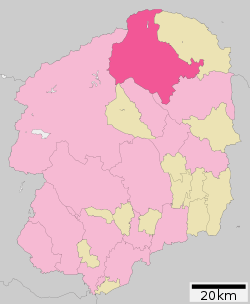Nasushiobara
Nasushiobara (那須塩原市, Nasushiobara-shi) is a city located in Tochigi Prefecture, Japan. As of 1 August 2020, the city had an estimated population of 115,794 in 48,437 households[1], and a population density of 67 persons per km². The total area of the city is 592.74 square kilometres (228.86 sq mi).
Nasushiobara 那須塩原市 | |
|---|---|
Nasushiobara City Hall | |
 Flag  Seal | |
 Location of Nasushiobara in Tochigi Prefecture | |
 Nasushiobara | |
| Coordinates: 36°57′42.2″N 140°2′45.8″E | |
| Country | Japan |
| Region | Kantō |
| Prefecture | Tochigi |
| Area | |
| • Total | 592.74 km2 (228.86 sq mi) |
| Population (August 2020) | |
| • Total | 115,794 |
| • Density | 200/km2 (510/sq mi) |
| Time zone | UTC+9 (Japan Standard Time) |
| - Tree | Pine |
| - Flower | Yatsuo Tsutsuji (Rhododendron pentaphyllum var. nikoense) |
| Phone number | 0287-62-7117 |
| Address | 108-2, Kyōkonsha, Nasushiobara-shi, Tochigi-ken 325-8501 |
| Website | Official website |
Geography
Nasushiobara is the northernmost city in the Kantō region of Japan, bordering Fukushima Prefecture to the north. It is located in the northern portion of Tochigi Prefecture, in the mountains.
Surrounding municipalities
Climate
Nasushiobara has a Humid continental climate (Köppen Cfa) characterized by warm summers and cold winters with heavy snowfall. The average annual temperature in Nasushiobara is 10.9 °C. The average annual rainfall is 1475 mm with September as the wettest month. The temperatures are highest on average in August, at around 23.5 °C, and lowest in January, at around -0.9 °C.[2]
| Climate data for Kuroiso (2015) | |||||||||||||
|---|---|---|---|---|---|---|---|---|---|---|---|---|---|
| Month | Jan | Feb | Mar | Apr | May | Jun | Jul | Aug | Sep | Oct | Nov | Dec | Year |
| Record high °F | 54.1 | 57.0 | 68.4 | 81.9 | 86.4 | 82.8 | 91.8 | 94.8 | 83.1 | 75.2 | 70.5 | 63.1 | 94.8 |
| Average high °F | 41.7 | 43.0 | 49.5 | 60.6 | 68.9 | 74.1 | 80.2 | 83.1 | 75.7 | 66.0 | 56.3 | 47.1 | 62.2 |
| Daily mean °F | 35.1 | 35.1 | 42.8 | 52.2 | 63.3 | 66.4 | 74.3 | 73.8 | 66.4 | 57.7 | 50.2 | 41.0 | 54.9 |
| Average low °F | 24.4 | 25.3 | 30.4 | 39.6 | 49.1 | 57.9 | 65.5 | 67.6 | 60.6 | 48.6 | 37.0 | 28.6 | 44.6 |
| Record low °F | 18.0 | 20.7 | 24.4 | 29.3 | 38.1 | 46.0 | 58.1 | 60.1 | 49.8 | 37.4 | 31.5 | 21.0 | 18.0 |
| Average precipitation inches | 1.4 | 0.9 | 3.4 | 4.7 | 1.8 | 5.0 | 10.0 | 5.8 | 9.3 | 1.4 | 4.1 | 2.6 | 50.4 |
| Record high °C | 12.3 | 13.9 | 20.2 | 27.7 | 30.2 | 28.2 | 33.2 | 34.9 | 28.4 | 24.0 | 21.4 | 17.3 | 34.9 |
| Average high °C | 5.4 | 6.1 | 9.7 | 15.9 | 20.5 | 23.4 | 26.8 | 28.4 | 24.3 | 18.9 | 13.5 | 8.4 | 16.8 |
| Daily mean °C | 1.7 | 1.7 | 6.0 | 11.2 | 17.4 | 19.1 | 23.5 | 23.2 | 19.1 | 14.3 | 10.1 | 5.0 | 12.7 |
| Average low °C | −4.2 | −3.7 | −0.9 | 4.2 | 9.5 | 14.4 | 18.6 | 19.8 | 15.9 | 9.2 | 2.8 | −1.9 | 7.0 |
| Record low °C | −7.8 | −6.3 | −4.2 | −1.5 | 3.4 | 7.8 | 14.5 | 15.6 | 9.9 | 3.0 | −0.3 | −6.1 | −7.8 |
| Average precipitation mm | 36 | 23 | 86 | 119 | 45 | 126 | 253 | 148 | 237 | 35 | 105 | 65 | 1,278 |
| Mean monthly sunshine hours | 154.4 | 158.4 | 177.8 | 177.8 | 163.4 | 116.9 | 110.2 | 127.1 | 110.3 | 132.0 | 144.3 | 153.9 | 1,722.6 |
| Source 1: 理科年表 | |||||||||||||
| Source 2: Japan Meteorological Agency (averages:1981-2010, peaks:1888-present)[3][4] | |||||||||||||
Demographics
Per Japanese census data,[5] the population of Nasushiobara has increased steadily over the past 100 years.
| Year | Pop. | ±% |
|---|---|---|
| 1920 | 35,992 | — |
| 1930 | 40,465 | +12.4% |
| 1940 | 44,613 | +10.3% |
| 1950 | 60,471 | +35.5% |
| 1960 | 60,948 | +0.8% |
| 1970 | 69,009 | +13.2% |
| 1980 | 85,436 | +23.8% |
| 1990 | 97,771 | +14.4% |
| 2000 | 110,828 | +13.4% |
| 2010 | 117,706 | +6.2% |
History
Before the Meiji period, the area which is now Nasushiobara was mostly uninhabited wasteland, due to lack of suitable water for agriculture. Ōtawara Domain built a number of irrigation canals during the Edo Period, but the scale was small. However, in the Meiji period, the Nasu Canal and other agricultural development projects aimed at opening the region to farming led to rapid development, and many local place names still bear the names of various government officials of the Meiji period. With the establishment of the modern municipalities system on April 1, 1889, the villages of Karino, Takabayashi, Nabekake, Nishi-Nasuno, Higashi-Nasuno in Nasu District, and Shiobara in Shioya District were formed. A portion of Higashi-Nasuno became the town of Kuroiso in 1912. Shiobara became a town in 1919, and Nishi-Nasuno in 1932. In 1955, Kuroiso annexed Takabayashi, Nabekake and the remainder of Higashi-Nasuno, and Nishi-Nasuno annexed Kariya. Kuroiso became a city in 1970, and Shiobara was transferred to Nasu District in 1982. The modern city of Nasushiobara was established on January 1, 2005, from the merger of the former city of Kuroiso, and the towns of Nishinasuno and Shiobara (both previously constituent towns of Nasu District).
Government
Nasushiobara has a mayor-council form of government with a directly elected mayor and a unicameral city assembly of 26 members. Nasushiobara, together with the town of Nasu collectively contributes four members to the Tochigi Prefectural Assembly. In terms of national politics, the city is part of Tochigi 3rd district of the lower house of the Diet of Japan.
Economy
Nasushiobara relies heavily on seasonal tourism to its hot spring and ski resorts. Agriculture is centered on dairy production. The city mascot, Miruhi, was created to represent the city's dairy production. The city also has several industrial parks.
Education
- Utsunomiya Kyowa University
- Nasushiobara has 20 public primary schools, ten public middle schools and one combined primary/middle school operated by the city government. The city has four public high schools operated by the Tochigi Prefectural Board of Education. The prefectural also operates one special education school for the handicapped.
Transportation
Highway
.png)



Local attractions
Nasushiobara serves as a gateway for tourism in northern Tochigi.
- Shiobara onsen
- Itamuro onsen
- former house of Aoki Shuzo
- Nogi Jinja (former residence of General Nogi Maresuke
- former Shiobara Imperial Palace
- Hunter Mountain Shiobara
- Momiji-dani Suspension Bridge
Noted people
- Hiromi Hara, professional football player
- Yoko Shibui, Olympic runner [6]
- Aya Hirayama, actress
- Yoshimi Watanabe, politician
- Masayoshi Takayama, three-star Michelin head chef of the Manhattan sushi restaurant Masa (born in Kuroiso)
References
- "Nasushiobara City official home page" (in Japanese). Japan.
- Nasushiobara climate data
- "平年値(年・月ごとの値)". Japan Meteorological Agency. Retrieved 2012-08-10.
- "観測史上1~10位の値(年間を通じての値)". Japan Meteorological Agency. Retrieved 2012-08-10.
- Nasushiobara population statistics
- Sports-Reference.com
External links
![]()
- Official Website (in Japanese)
- Shiobara Onsen